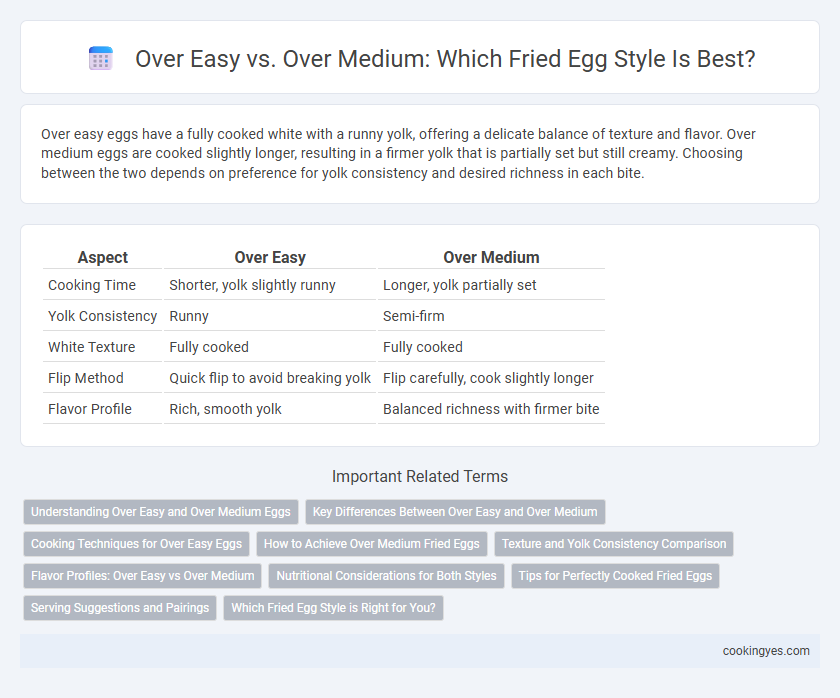Over easy eggs have a fully cooked white with a runny yolk, offering a delicate balance of texture and flavor. Over medium eggs are cooked slightly longer, resulting in a firmer yolk that is partially set but still creamy. Choosing between the two depends on preference for yolk consistency and desired richness in each bite.
Table of Comparison
| Aspect | Over Easy | Over Medium |
|---|---|---|
| Cooking Time | Shorter, yolk slightly runny | Longer, yolk partially set |
| Yolk Consistency | Runny | Semi-firm |
| White Texture | Fully cooked | Fully cooked |
| Flip Method | Quick flip to avoid breaking yolk | Flip carefully, cook slightly longer |
| Flavor Profile | Rich, smooth yolk | Balanced richness with firmer bite |
Understanding Over Easy and Over Medium Eggs
Over easy eggs have lightly cooked whites and runny yolks, creating a delicate texture ideal for those who enjoy a soft, creamy center. Over medium eggs feature firmer whites and yolks that are partially set but still slightly runny, striking a balance between softness and solidity. Understanding these distinctions helps in selecting the perfect fried egg based on yolk consistency preferences and desired culinary experience.
Key Differences Between Over Easy and Over Medium
Over easy eggs are fried on one side and flipped briefly, leaving the yolk runny and the whites mostly set, ideal for those who prefer a softer texture. Over medium eggs cook longer after flipping, resulting in a slightly firmer yolk that is partially cooked but still creamy, providing a balance between runny and fully cooked. The key difference lies in cooking time and yolk consistency, with over easy offering a delicate runny yolk and over medium presenting a more substantial, partially cooked center.
Cooking Techniques for Over Easy Eggs
Over easy eggs require a precise cooking technique where the egg is fried on one side until the white sets before gently flipping it to cook the yolk lightly, keeping it runny. Maintaining medium heat prevents the egg white from overcooking while ensuring the yolk remains soft, essential for achieving the signature texture of over easy eggs. Mastery of timing and heat control distinguishes over easy eggs from over medium, which cooks the yolk more thoroughly.
How to Achieve Over Medium Fried Eggs
To achieve over medium fried eggs, cook the egg sunny side up until the whites are mostly set, then gently flip and cook for an additional 30 to 45 seconds to firm up the yolk without fully hardening it. Maintaining medium heat prevents overcooking while ensuring the yolk remains slightly runny yet thicker than over easy eggs. Using a non-stick pan and a thin spatula helps flip the egg carefully to preserve its shape and texture.
Texture and Yolk Consistency Comparison
Over easy eggs have a delicate, slightly runny yolk with a lightly set white, offering a tender texture that caters to those who enjoy a soft, creamy consistency. Over medium eggs feature a yolk that is partially set but still moist, providing a firmer texture than over easy while maintaining some softness. The primary difference lies in yolk firmness and white texture, with over easy delivering a more liquid yolk and over medium offering a thicker, custard-like center.
Flavor Profiles: Over Easy vs Over Medium
Over easy eggs offer a delicate balance with a tender white and a runny yolk, providing a rich, buttery flavor that enhances the egg's natural sweetness. Over medium eggs feature a firmer yolk with a slightly creamy center, delivering a richer, more robust taste and a denser texture. The subtle difference in yolk consistency between over easy and over medium eggs significantly influences the flavor intensity and mouthfeel.
Nutritional Considerations for Both Styles
Over easy and over medium eggs differ slightly in cooking time, influencing their nutritional profile. Over easy eggs have a runnier yolk, preserving more moisture, vitamins like B12 and D, whereas over medium eggs are cooked longer, slightly reducing some heat-sensitive nutrients but increasing protein digestibility. Both styles provide similar calorie and fat content, making them nutritious choices depending on texture preference.
Tips for Perfectly Cooked Fried Eggs
Achieving perfectly cooked fried eggs depends on precise temperature control and timing; over easy eggs cook at medium heat for about 2 minutes per side, yielding a runny yolk with set whites, while over medium eggs require an extra 30-45 seconds to partially set the yolk. Using a non-stick skillet and a small amount of butter or oil helps prevent sticking and ensures even cooking. Gently flipping the egg with a thin spatula minimizes yolk breakage, maintaining the ideal texture for each desired doneness.
Serving Suggestions and Pairings
Over easy fried eggs, with their slightly runny yolks, pair exceptionally well with toasted bread, crispy bacon, or fresh avocado for a balanced breakfast. Over medium eggs offer a firmer yolk that complements heartier dishes like hash browns, sausage links, or sauteed vegetables, making them ideal for brunch plates. Both styles enhance meals with hash toast, English muffins, or fresh herbs such as chives and parsley for added flavor.
Which Fried Egg Style is Right for You?
Choosing between over easy and over medium fried eggs depends on your preferred egg yolk consistency. Over easy eggs have a lightly cooked yolk that's still runny, perfect for those who enjoy dipping toast or mixing yolk with other breakfast items. Over medium eggs offer a yolk that's partially set but still creamy, ideal for people wanting a balance between runny and fully cooked textures.
Over easy vs Over medium for fried eggs Infographic

 cookingyes.com
cookingyes.com